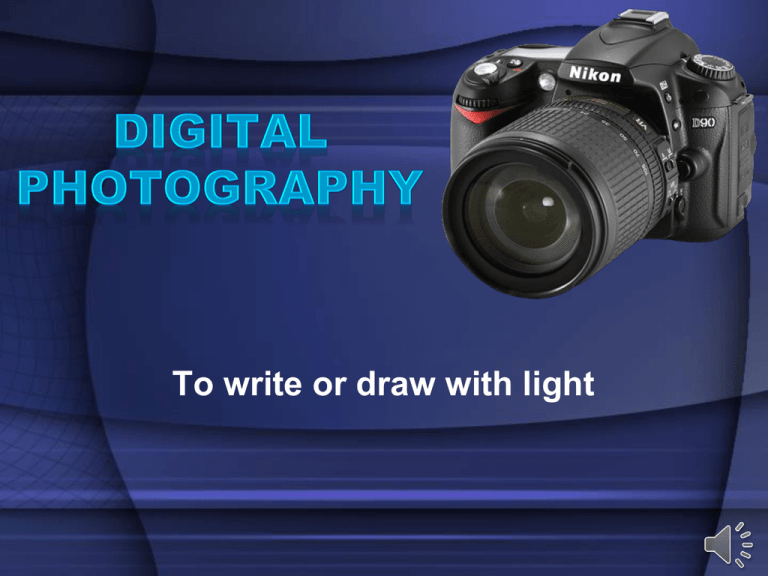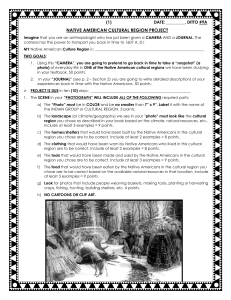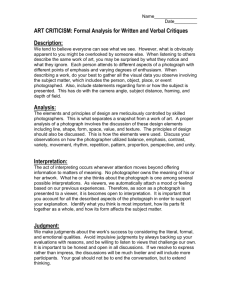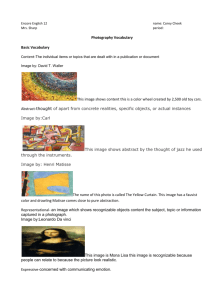Digital Photography To write or draw with light
advertisement

To write or draw with light Why do people take Photographs? Camera Parts Digital camera • captures the photo with electronic imaging sensor LCD Screen Shutter Button Flash Camera Body Lens Camera Parts iPhone: To quickly open Camera when iPhone is locked, swipe up. Camera Lens Flash Exposure Triangle Exposure: • amount of light captured by the camera. ISO: • measurement of a camera’s sensitivity to light. Shutter Speed: • how long its shutter stays open as the picture is taken. Aperture: • small, circular opening inside the camera lens • controls amount of light reaching the sensor Aperture + Shutter Speed + ISO = Exposure Triangle The aperture and shutter speed together control the total amount of light reaching the sensor. Shutter & Aperture Technical Terms Pixel – Short for Picture Element, a pixel is a single point in a graphic image Megapixel = 1 million pixels Technical Terms Resolution = number of pixels in an image PPI – Pixels Per Inch Is it better to have more or less pixels? DOCUMENTARY Photo Types Alfred Stieglitz, The Terminal, 1892 Alfred Stieglitz, The Steerage, 1907 DOCUMENTARY Charles C. Ebbets, Lunch atop a Skyscraper, 1932 EXPRESSIVE • Communicating an emotion Dorothea Lange, Migrant Mother Patrick Farrell , Untitled EXPRESSIVE William Klein, Gun #1 LANDSCAPE • the natural environment. Ansel Adams, Tetons and the Snake River LANDSCAPE • the natural environment. Eddie Soloway ORGANIC SHAPE • shapes based on natural objects such as trees, mountains, leaves, etc… Eddie Soloway Ansel Adams, Roots ABSTRACT • emphasizes formal elements (line, shape, etc.) rather than specific, recognizable objects Eddie Soloway PORTRAITURE • to capture the personality of the subject or group of subjects on film. Candid Posed • Where the horizontal and vertical lines intersect makes an ideal location for the more important parts of your picture. • By locating your main subject at one of the four intersections you give the subject more emphasis than if it was right smack in the middle of the picture. Visual Elements Composition • • • • • • • • Line Space Texture Repetition Shape Value Color Light • • • • • • • Balance Contrast Central Focus Background Angle (vantage Point) Framing Setting Lighting Ambient Light • natural light Joe McNally Artificial Light • electrical light Visual Elements Texture: if you could touch the surface of the photograph how would it feel? How do the objects in the picture look like they would feel? Light: what areas of the photograph are most highlighted? Are there any shadows? Does the photograph allow you to guess the time of day? Is the light natural or artificial? Harsh or soft? Reflected or direct? Line: are there objects in the photograph that act as lines? Are they straight, curvy, thin, thick? Do the lines create direction in the photograph? Do they outline? Do the lines show movement or energy? Space: is there depth to the photograph or does it seem shallow? What creates this appearance? Are there important negative spaces in addition to positive spaces? Is there depth created by spatial illusions? Focus: what areas appear clearest or sharpest in the photograph? What do not? Repetition: are there any objects, shapes or lines which repeat and create a pattern? Shape: do you see geometric or organic shapes? What are they Value: is there a range of tones from dark to light? Where is the darkest value? Where is the lightest? Composition of the Photograph Angle: the vantage point from which the photograph was taken; generally used when discussing a photograph taken from an unusual or exaggerated vantage point. Background: the part of a scene or picture that is or seems to be toward the back. Balance: the distribution of visual elements in a photograph. Symmetrical balance distributes visual elements evenly in an image. Asymmetrical balance is found when visual elements are not evenly distributed in an image Balance: the distribution of visual elements in a photograph. Asymmetrical balance is found when visual elements are not evenly distributed in an image. Central focus: (focal point); the objects(s) which appears most prominently and/or most clearly focused in a photograph. Contrast: strong visual differences between light and dark, varying textures, sizes, etc. Vantage point: the place from which a photographer takes a photograph. Framing: what the photographer has placed within the boundaries of the photograph. Lighting can make or break your photo When it comes to the direction of light, there are 360 degrees of possibilities. When the light isn't working for you, change it by moving your position, your subject's position, or the light itself, if possible. High Front Light (Sunlight) Front Light Side Light Back Light Photo Tips Fill Flash Flash Off Photo Tips Good Better ZOOM IN Photo Tips FOCUS Photo Tips Format and Orientation Photo Tips DISTRACTING BACKGROUD? Simplify the scene Photo Tips Space to move Fill the frame Watch for mergers WHICH IS THE BETTER PHOTO?








